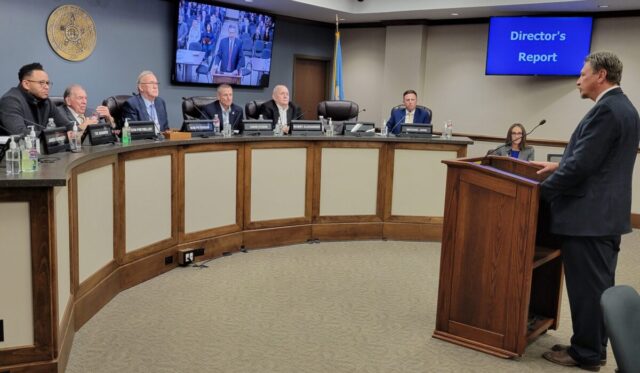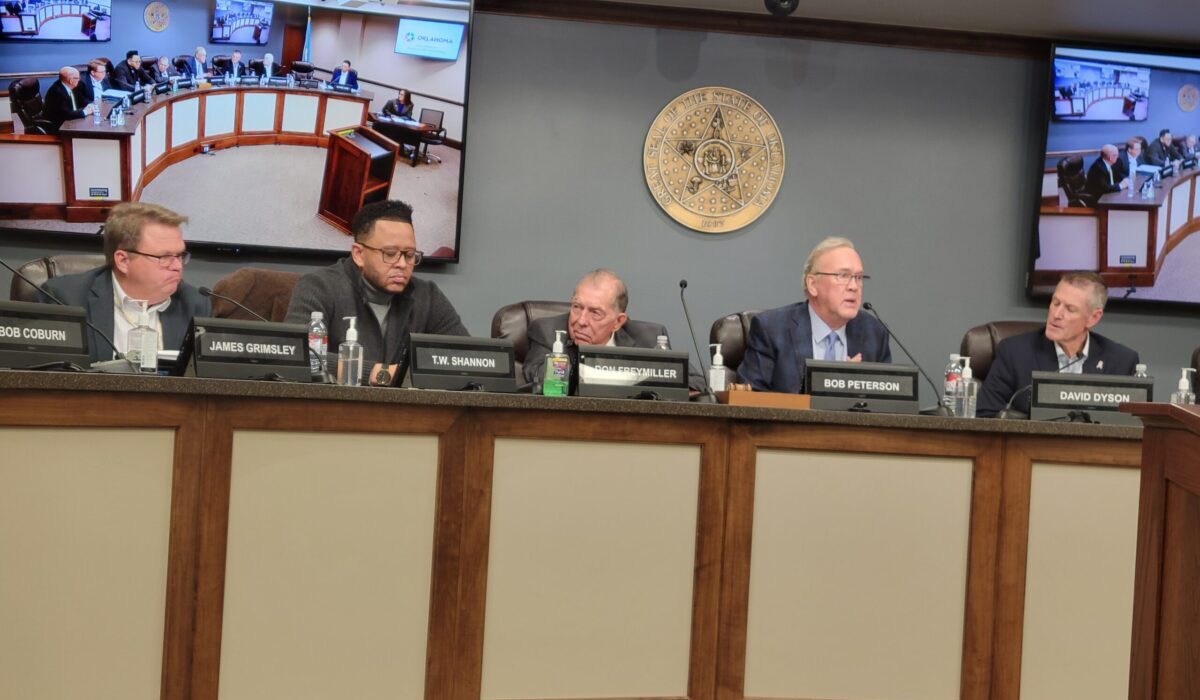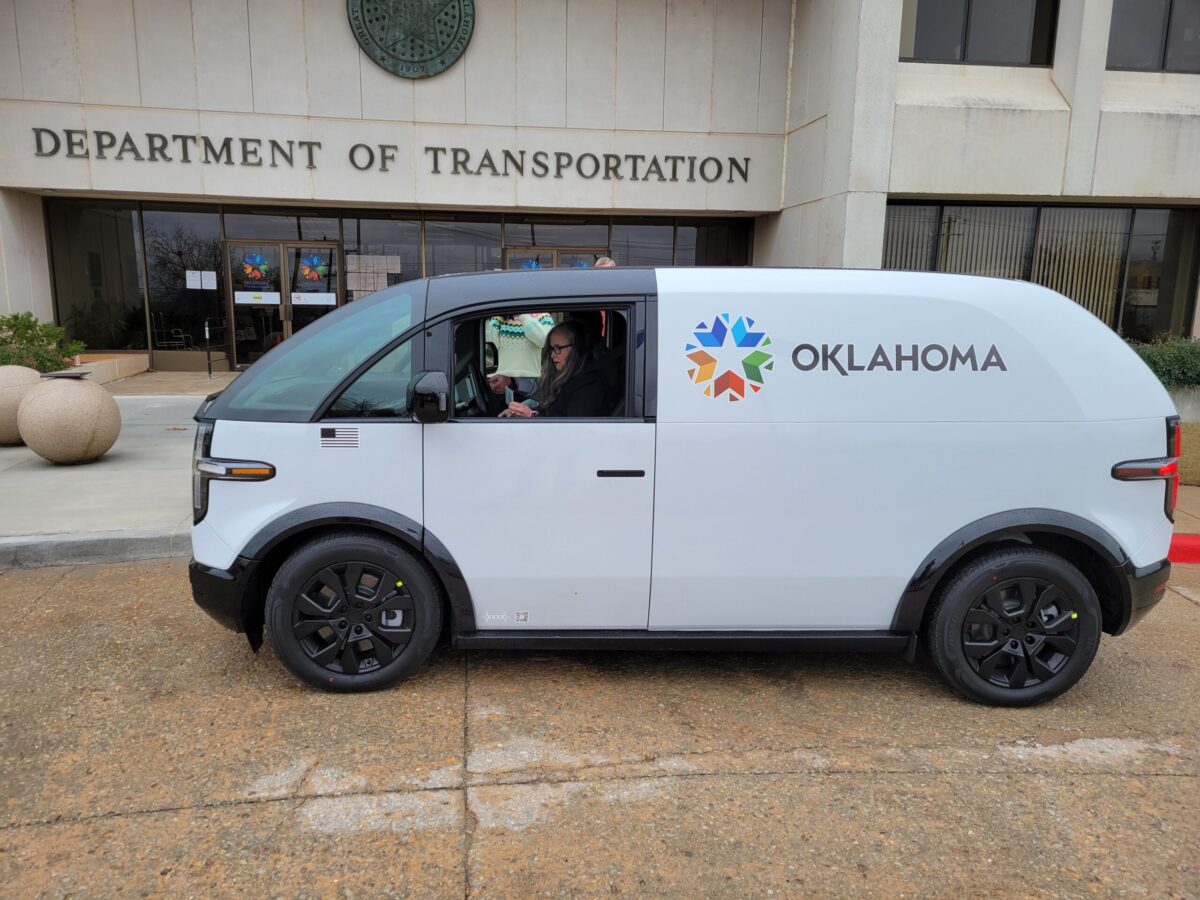
The Oklahoma Transportation Commission on Monday recommended a 30 percent increase for the executive director of the Department of Transportation, who also serves as executive director of the Oklahoma Turnpike Authority and on the governor’s Cabinet as secretary of transportation.
After meeting for nearly an hour in executive session, commissioners voted 8-0 to recommend to Gov. Kevin Stitt that Secretary Tim Gatz’s salary be increased from $185,000 to $245,000 a year. If Stitt approves the pay raise, Gatz would become the latest among state agency heads to receive a pay raise of at least $10,000 a year.
A report last year showed 49 directors received pay raises the past fiscal year, with 35 receiving a raise of at least $10,000. Thirteen of those 35 received pay increases that were double that amount or more, according to the Agency Director Salary Increase Report for the 2023-2024 fiscal year.
Gatz told commissioners that all of the nearly 2,300 ODOT employees will be receiving an across-the-board pay raise as a result of a recent comprehensive market study. He said the raises will range from 3 to 14 percent and will take effect later this month.
All state employees, meanwhile, have reason to hope they could receive a pay raise starting in July after a powerful lawmaker filed legislation proposing a 9 percent across-the-board increase for those working for state agencies. If it can clear all the legislative hurdles and wins the governor’s approval, SB 1292 would be the first across-the-board pay increase for state employees since they received a $1,250 across-the-board raise in 2019.
‘One of the biggest challenges we have in state government’
The last pay increase for Gatz, who has worked 34 years for ODOT, also came in 2019. He was appointed by Stitt earlier that year as secretary of transportation, and the Oklahoma Transportation Commission named him the agency’s executive director when Mike Patterson retired. At the time, Gatz was already serving as executive director of the Oklahoma Turnpike Authority, a position he assumed in 2016. Now, he heads both agencies, with each providing half his salary. His Cabinet position is unpaid.
Commissioner Michael Junk said Monday that commissioners wanted to reward Gatz for his leadership and for the many years he has worked at ODOT.
“One of the biggest challenges we have in state government is when you establish good leadership [you want] to maintain them,” he said. “We’re so thrilled to have you here. You’ve done such a tremendous job and a true public servant not only for ODOT but the whole state.
“Everyone on this commission recognizes that you need an increase in your salary. We don’t want to risk losing you.”
Gatz started his career at ODOT as a drafting technician in 1990. In 2000, he became manager of the Project Management Division where he was instrumental in the development of ODOT’s eight-year Construction Work Plan. Gatz was promoted to director of capital programs and information management in 2006 and led the department’s coordination with county governments to develop and deliver the County Improvements for Roads and Bridges Program, which provides dedicated funds for high-priority county transportation projects statewide. He served as deputy director from 2013 until his appointment to OTA in 2016.
Oklahoma Transportation Commission Chairman Bob Peterson said Gatz has been an instrumental leader of ODOT for years and the commission recognizes his professionalism and guidance.
“Tim Gatz has helped ODOT make big strides in addressing inadequate shoulders along rural two-lane highways, improving seatbelt usage statewide and reminding all Oklahomans every month how important safety is on our highway network,” Peterson said in a statement. “He has also helped guide the agency by working closely with federal, state and local partners to achieve some of the largest construction contracts ODOT has ever seen.”
Salary increases already set for ODOT employees

During Monday’s meeting, Gatz told commissioners that a market study plan recommending pay raises for his approximately 2,300 ODOT employees will take effect later this month, regardless of what the Legislature does or does not to in the 2024 regular session. Raises would range from 3 to 14 percent.
“This is truly trying to keep up with the market,” he said.
Gatz said it’s challenging to keep experienced employees.
“It is incumbent upon us to build an agency that provides the right opportunities and compensation levels to be able to support a good effort for the future,” he said.
The cost of the pay increases will be about $10 million a year, he said. The cost will not require an increase in state appropriations, he said. Instead, the raises will be paid through agency savings, such as not filling vacant positions that the agency has been unable to fill.
“We will absorb it in efficiencies,” Gatz said. “There is no more important investment that we can make than an investment in our people. The reason that we perform at the level we do is because of them.”
ODOT employs a wide array of professionals, such as engineers, attorneys, accountants and heavy equipment operators.
“We’ve got to be attentive across that whole organizational structure,” Gatz said. “When you make an investment in an employee, and you train them up and you get them used to the business of the department, and then you lose that individual, there’s a huge cost to that.
“If we train them up, we want to be able to keep them, and part of that is to compensate them to the extent that we have the ability to.”
Tony Desha, executive director of the Oklahoma Public Employees Association, applauded Gatz for implementing a pay increase for employees.
Oklahoma state government has an employee turnover rate of 21 percent, mostly caused by the lack of competitive pay, he said.
“All the agencies are seeing it,” Desha said. “At ODOT, their biggest turnover rate is their engineers. They get them all certified, get them all trained up, and just as soon as they become a good functioning employee, they jump over to the private market for a huge pay raise.”
Thompson proposes 9 percent pay increase for state employees

When the 2024 regular session of the Oklahoma Legislature starts Feb. 5, the topic of state employee pay raises is expected to be a prime topic in budgeting discussions. The Senate, which has pledged to hold additional open hearings and reveal its budget position publicly this year, could leverage concerns over state employee compensation against the Stitt administration’s push for a variety of tax cuts.
Proposing a 9 percent across-the-board increase for state employees, Senate Appropriations and Budget Chairman Roger Thompson (R-Okemah) said he filed SB 1292 because a raise for state workers is overdue and would send a message that their work is appreciated. State employees have lost about 18 percent of their buying power since their last pay raise in 2019, he said.
“I’m getting some positive conversations about it from some of the members,” Thompson said Monday.
However, SB 1292 carries a price tag of about $173 million in a session where competition will be heated over how state dollars are appropriated.
“Whether it passes in the end, I don’t know,” Thompson said. “You’ve also got people in powerful positions looking for tax cuts and getting rid of revenue, so it’s going to be hard to do it all.”
Thompson said Oklahoma has to address the state’s high turnover rate among agency employees.
“If we really want the people of Oklahoma to have good services, then we need to have good employees to wait on them,” he said.
Desha said OPEA supports Thompson’s proposal, which would land on top of the ODOT raises already slated to take effect this month.
“It’s a great start,” Desha said. “Most state employees are 20 percent below market, so I think 9 percent is a great place to start.”
In previous years, OPEA supported a market-based pay plan, and implementing such a process could take two years, he said.
“We’ll continuously slide further and further back (if we don’t),” he said.
On average, a 9 percent raise could mean an annual increase of about $5,000 to $6,000, Desha said. State employees receive an annual salary of about $45,000.
“I’m really happy that we got this bill started and that Roger Thompson seems so excited about it,” he said.
ODOT receives Canoo vehicle made in Oklahoma

As an innovative part of the state’s ongoing fleet modernization initiative, Gatz told commissioners ODOT was one of three agencies to receive the first made-in-Oklahoma electric vehicles from Canoo, a company whose controversial business incentives have been questioned for the last two years.
Dubbed a “Lifestyle Delivery Vehicle,” the new vans have also been assigned to the Office of Management and Enterprise Services and the Department of Corrections.
The LDVs are the first commercial motor vehicles built in-state since 2006 and the first to come out of Canoo’s new assembly facility in the 9500 block of West Interstate Service Road in Oklahoma City, which experienced a burglary in August.
According to a heavily redacted Oklahoma City Police Department report, an unidentified individual broke in and took a Canoo prototype on a low-speed test drive around the property.
“Suspect attempted to make entry into one of the vehicle(s) and did not have success. Suspect got one of the vehicles to open and unplugged it,” the OKCPD report states. “Suspect flipped the switch on the rear of the vehicle and it turned on. Suspect opened the garage door and leaves with the vehicle.”
Although the information is redacted on OKCPD’s document, a department official confirmed the prototype was valued above $1 million.
Gatz said Monday his agency will be evaluating how electric vehicles can be used at ODOT and other state agencies. The Canoo will be assigned to ODOT’s multimodal division, which houses the agency’s rail, mobility and waterways programs.
“I’ll be quick to tell you that at the Department of Transportation you’re not going to see a wholesale conversion of our fleet to electric vehicles or anything like that because of the nature of our business doesn’t necessarily accommodate that,” he said. “However, there is a place for this vehicle in our operations.
“We’ll use this vehicle as an opportunity to help us advocate for a broader utilization of EVs across the state.”





















